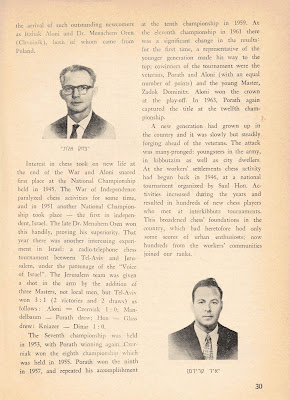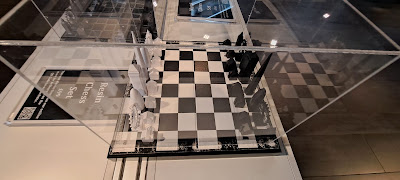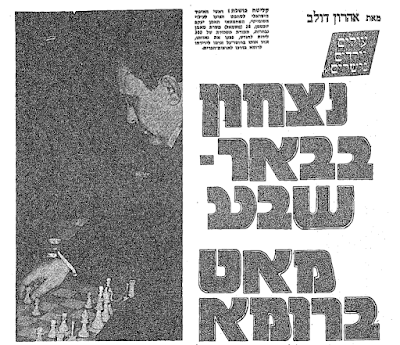Source: see below
Tuesday, December 31, 2024
More Caricatures By Ross
Achievements in Old Age
Source: Chess Review, May 1965, p. 131
Achievements in chess in old age are a matter of historical times. Today, the youngest world champion - only 18 - had just been crowned. In the past many players were active into old age and occasionally won important tournaments, Emmanuel Lasker and Jacque Mieses being two well-known examples. In the above clip, brought to our attention by Herbert Halsegger, it is noted that Miguel Najdorf won at Mar de Plata against a strong field at the relatively old age of 55. All three of these masters were, of course, Jewish.
The interesting thing is that the winners of the second and third place, Averbakh and Stein, were 12 and 24 years younger, respectively. What is the largest age difference, in a major tournament, between the winner and the runner-up(s)?
Saturday, November 30, 2024
Israel in the Finals
"Shachmat"''s own Potted Version of Israeli Chess History up to 1964
What was the ICF's own view of the history of chess in Israel? A potted history - in English - was found on pp. 31-29 of Shachmat, November 1964 (vol. 3, no. 4). The page numbers are reversed - 31 being the first page of the article - since this history is in the English language section of the magazine, written from left to right, while the rest of the magazine is in Hebrew, from right to left...
Typical of the era was the fact that there were a few "screw ups": the pictures, of Porat, Aloni, and Kraidman (in order) had the names of the players in tyhe photo in Hebrew, not in English, and - incidentally - the November 1964 volume itself has the date "October 1964" by mistake on the front cover.
Monday, November 18, 2024
Some Popular Articles about the Jewishness (or Otherwise) of Chess Masters
Friday, October 4, 2024
Sammy Rubinstein, a Simultaneous Display by his Father, and the Need for Sources
1. While superficially similar, the photograph here is not actually in the same room.2. The people in the photo are dressed in conservative black - not how people would dress in Palestine back then (although the difference is somewhat subtle). Similarly, golden watches and pipes, while not unknown, were not common in Palestine. In short, the Palestine simuls were much more "working class" than this display.3. All the sets are matching sets, of the same size/making. This would not be typical of Palestine of the time, where it was customary for players in simultaneous displays to bring their own sets. Local chess clubs simply didn't have 50 or 100 matching sets available.4. The demonstration board in the back seems to be in German or another European language, not Hebrew.5. I do not recognize any of the players/personalities in your photo.6. In many of Rubinstein's simuls in Palestine, the players were mobbed and assisted by their neighbors/onlookers - very typical of the time in Palestine, but not in Europe (to the great chagrin of Palestine chess column editors, who tried to uproot this "uncivilized" practice...). Here the onlookers are not doing so.
Saturday, September 28, 2024
"Fancy" Sets
Graves of Non-Masters
Above is a photo I took of the grave of Vladimir Ze'ev Shteinberg, 1965-2024. He is buried in the Ganei Ester Cemetary, Rishon LeZion, Israel. He was not a chess master, but he was a good amateur player, with a FIDE rating of 2180. He also held the Israeli chess rank of senior candidate master, according to his ICF player's page (in Hebrew).
Graves of chess masters often have a chess theme, as Edward Winter's article on the subject shows. But I am not aware of many graves of non-masters having such a theme. Does any reader know of similar chess motifs on the graves of non-masters?
Saturday, August 31, 2024
Fischer in Reykjavik... in 1961
Source: Chess Life, vol. 16 no. 2 (February 20, 1961), p. 37
Mr. Herbert Halsegger notifies us that Fischer was in Iceland, winning in Reykjavik... already in 1961, in a small round-robin tournament against the Icelandic players, including the GM Fredrik Oalfsson. 11 years before his rather better known victory against GM Boris Spassky in the same location...
Lithuanian Jewish Chess
Tuesday, August 13, 2024
More About Yuchtman
"Victory in Be'er-Sheva - Mated in Rome," by Aharon Dolev. Source: Yamim Ve'leylot (Days and Nights), Ma'ariv's weekly supplement, 7 September 1973, p. 4 (article on pp. 4-5, 45).
Sunday, August 11, 2024
Jacob Yuchtman
Monday, August 5, 2024
Ross' Caricatures
We have noted in this blog Ross' caricature of Itzchak Aloni. Now, Mr. Herbert Halsegger notifies us that the caricature, together with those of many other masters - see list in the bottom of the post under "תוויות" (subjects) - are found in a Chess Review article of the 1964 olympiad, March 1965, pp. 78-81. Two are given above; the rest can be found in the article itself. In particular, there are caricatures of the entire USSR team.
P.S.
Trying to find more information about Ross, I googled in Hebrew "רוס מאייר" - "Ross illustrator." As it happens, this is the way you spell in Hebrew the independent (if that is quite the word) film maker Russ Meyer, which google gave me a lot of, how shall we say, educational information about (link goes to Wikipedia's biography of him).
Sunday, August 4, 2024
Alla Kushnir
Tuesday, July 23, 2024
Nice Photo of Porat
Orang-Utan
Chess Olympiad Package
Sunday, July 21, 2024
Right to Left
Source: Doar Ha'yom, 17 September 1922, p. 4
Tuesday, July 16, 2024
(Not) Being There
Saturday, July 6, 2024
Wartime Chess
A frequent correspondent notes the following picture in the Jabotinsky Institute's archives. It is photo #6582, from 1943 Italy, showing "an international chess tourney with the participation of Jewish soldiers from England, Palestine, and Poland." Note the wartime "We shall win" (in Hebrew) poster on the wall, featuring Churchill.
Wednesday, July 3, 2024
Uzi Geller, 1931-2024
Tuesday, July 2, 2024
Schahmuseum
Monday, July 1, 2024
Chess Gift
The above chess set, a gift to captain William H. Barker, was presented in 1947 to him by those whom he took care of in a DP camp after the second world war. It is found on the Facebook site of the Jewish Museum in Vienna, as Mr. Herbert Halsegger notifies us.
Sunday, June 30, 2024
Persitz Making an Impression
Aloni Making an Impression
Saturday, June 29, 2024
Baron, Banker, Chess Master - and Grandson of a Rabbi
"The Flower of Youth"
Mosheh Oved
Samuel Schweber
Tuesday, June 18, 2024
"What Time's the Next Swan?"
Chess and Sex
The British Foreign Office. Credit: Wikipedia.
In foreign office document FO 371/168255 from 5 June 1963, sent from the Havana embassy, Sir Herbert Marchant, then the British ambassador in Cuba, sent his superiors in the foreign office a review of the state of culture in Cuba after the revolution. He noted that "Havana has very few book-shops" but nevertheless there is a "plentiful supply of paper-back text books on Chess and Sex, both popular with Cubans."
The popularity of chess is understandable, due to Capablanca, of course, but why on earth would the other activity be popular in Cuba?
Wednesday, June 12, 2024
Dobkin vs. Czerniak in the Foreign Press
Mr. Halsegger, in his deep dive through old American chess magazines, also notes the following rare (for the time) report of an Israeli game - from the Israeli championship of 1956 - in the foreign press. The game Dobkin - Czerniak (0:1).
Israel vs. Mongolia, Moscow Olympiad, 1956
Bobby and Friends
Chess Booms
Our frequent correspondent Herbert Halsegger notes an article from a Jewish magazine for politics and culture about the chess boom in Israel in 2012 when Boris Gelfand played for the world championship with Viswanathan Anand.
This made us think about previous chess "booms." The recent one due to The Queen's Gambit is well known (and still ongoing) and so was the Fischer boom in the USA after Fischer won the world championship in 1972.
Are there any other examples of such "booms" in history? Did chess, for example, become noticeably more popular after the first international chess tournament, London, 1851?
Saturday, May 18, 2024
Palestine Tournaments in Chess Review, 1947
As Others See Us
The story goes that in 1923 Marcel Duchamp finally abandoned his “hilarious picture” of psychosexually contorted glass and wire, The Bride Stripped Bare by Her Bachelors, Even, to spend more time playing chess. He was certainly obsessed with the austere beauty of the game, famously pronouncing that “while all artists are not chess players, all chess players are artists.” For most of us, however, if we are minded to consider the aesthetic value of games at all, it is usually only in a derivative sense. We can appreciate the Art Deco elegance of Duchamp’s own custom-made chess set, for instance, without sharing his passion for obscure variations on opening d4.
"The Story goes." "Famously pronouncing." "Obscure variations on opening d4." Why is it that books or articles that mention chess are so often lacking in accuracy and sources?
Wednesday, May 15, 2024
On Edward Lasker, by Mona Karff
Biographical articles about chess players by other players are, of course, very common, but Herbert Halsegger notes an interesting example. Not only are both the subject and author Jewish - which is hardly surprising in chess! - but the author of the article about Edward Lasker is a female master, namely the Jewish Mona Karff. We should note that as we mentioned elsewhere, Edward Lasker had, in the same year, visited the chess olympiad in Haifa, 1976.




































.png)
.png)
.png)










